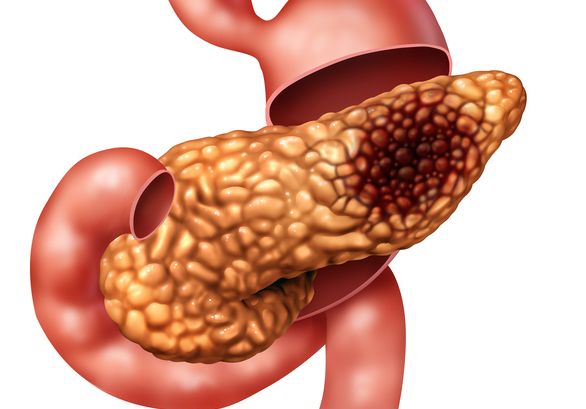
Mayo Clinic researchers suggest that the majority of patients with pancreatic ductal adenocarcinoma (PDAC) should be considered for staging laparoscopy with peritoneal lavage prior to resection.
The procedure could be particularly important for people with high-risk features such as young age, large tumor size, indeterminate extrapancreatic lesions on preoperative imaging, body or tail tumor location, and elevated serum cancer antigen (CA) 19-9, and should ideally be carried out prior to neoadjuvant chemotherapy.
“Accurate staging prior to resection of [PDAC] is imperative to avoid unnecessary operative morbidity and oncologic futility in patients with occult intra-abdominal distant metastases,” wrote first author Hallbera Gudmundsdottir and colleagues from the Department of Surgery at the Mayo Clinic in Rochester, Minnesota, in the Journal of the American College of Surgery.
Yet the number of patients undergoing this procedure has fallen substantially in recent years with the introduction of improved imaging techniques.
“We strongly believe that the decrease in utilization of this critical staging procedure is flawed,” senior author Mark Truty told Inside Precision Medicine.
“Although it is true that modern imaging has improved significantly, it still cannot assess lesions smaller than 5 mm, those on the surface of the liver, and peritoneal small volume disease is still radiologically not visible,” he said. “Furthermore, the incidence of metastatic disease has not changed over time, thus we still anticipate many patients to either harbor detectable metastases in the peritoneal cavity (if adequately evaluated) or to develop it after surgery which is still a common and unchanged proportion.”
The researchers believe that the value of staging laparoscopy needs to be re-evaluated in the modern era. To address this, they determined the diagnostic yield of the procedure in their institutional cohort of 1,004 patients (median age 66 years, 48% women) with radiographically localized PDAC were treated between 2017 and 2021.
Overall, 18% of patients had positive laparoscopy due to gross metastases (n=140) and/or positive peritoneal cytology (n=96). When the team restricted the analysis to the 721 patients who had a peritoneal lavage at the time of the staging procedure, metastatic disease was confirmed in 21%. In this same group, 42% of 96 patients with positive cytology did not have any gross metastatic disease.
“The significance of elevated peritoneal tumor markers in the absence of gross metastases or positive peritoneal cytology is unknown but may represent occult peritoneal tumor dissemination, although further studies are needed and are currently being performed at our center with consideration of repeat laparoscopy after neoadjuvant therapy,” the researchers wrote.
The investigators also carried out multivariate analyses to identify factors associated with an increased risk for positive laparoscopy. They found that the risk was a significant 6.8-fold higher among patients with, versus without, indeterminate extrapancreatic lesions on preoperative imaging.
In addition, individuals with a distally located tumor had a 2.8-fold higher risk than those with a proximal tumor, while a tumor size of 20 mm or larger was associated with a 2.3-fold increased risk for positive laparoscopy relative to a smaller tumor size.
Patients older than 60 years of age were 1.8 times more likely to have positive laparoscopy than their younger counterparts and an elevated serum CA 19-9 level (≥35 U/mL) was associated with a 1.7-fold increased risk.
Of note, the rate of positive laparoscopy in patients with no indeterminate lesions on preoperative imaging increased as the number of these risk factors increased, from 1.6% in patients with no risk factors to 42% in those with all four (i.e. age ≤60 years, body/tail location, size >2 cm, and elevated serum CA 19-9).
The low rate of positive laparoscopy among patients with none of the risk factors suggests that these patients could be excluded from the staging procedure. However, Truty noted that “the proportion of patients without any risk factors is very low.” For this reason, the team recommends “that the majority of patients, specifically anyone with one or more of these risk factors should have staging laparoscopy done prior to surgery and ideally prior to initiation of neoadjuvant therapy, which may obfuscate later laparoscopy findings if the patient’s tumor responds to therapy and thus the laparoscopy done later may be a false negative exam.”
Gudmundsdottir and co-authors concluded: “The yield of staging laparoscopy in patients with PDAC remains significant, even in the current era of high-quality imaging, and resulted in a change in management in one in five patients in our institutional cohort.”
Truty added that “by identifying patients who have occult peritoneal dissemination early on, we can then better choose the correct treatment for them. This can avoid unnecessary radiation and surgery as well as increase opportunities and eligibility for clinical trials for those that would otherwise not be candidates without the results of these staging procedures.”
Furthermore, if metastases are found, additional tissue can be sent for next-generation sequencing “to see if there are any actionable molecular targets, as the initial primary tumor needle biopsies tend to be poorly representative and often inadequate for such purposes,” he said.













